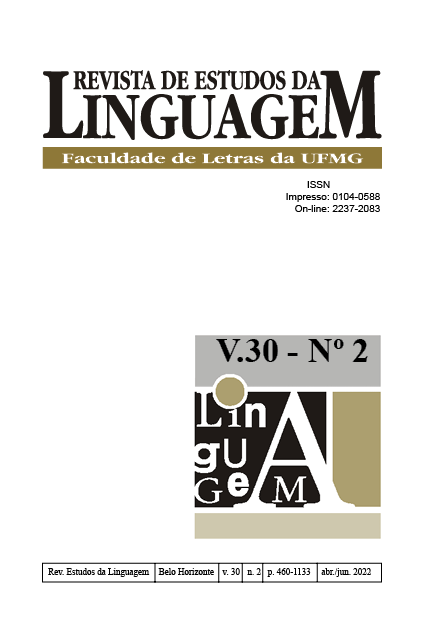A posição da oração completiva em construções subjetivas
o papel do design visual na dinâmica das construções
DOI:
https://doi.org/10.17851/2237-2083.30.2.871-905Palavras-chave:
construção subjetiva, modalidade e avaliatividade, uso linguístico, Gramática do Design VisualResumo
Neste artigo, investigam-se construções subjetivas de modalização (deôntica e epistêmica) e de avaliação, sob a perspectiva de modelos centrados no uso (BOYLAND, 2009; KEMMER; BARLOW, 1999), especialmente pressupostos da Linguística Centrada no Uso, que, segundo Diessel (2017) e Bybee (2016), apresenta aporte de base Funcionalista e da Linguística Cognitiva. Acrescente-se a contribuição da Gramática do Design Visual na dinâmica da construção subjetiva nos memes/postagens. As construções subjetivas são denominadas de construções subjetivas deônticas, subjetivas epistêmicas e subjetivas avaliativas, constituídas sintaticamente por oração matriz seguida da oração completiva subjetiva. A partir de 214 dados de uso coletados do site da rede social Facebook, observamos que a motivação discursiva determina a ordem da oração subjetiva avaliativa em relação à sua matriz, já que a topicalização da subjetiva na construção subjetiva avaliativa apresenta resultados bastante expressivos. Contrariamente, a construção subjetiva epistêmica preza pela posposição categórica da oração completiva. A oração matriz pode ser vista como um chunking, uma unidade sequencial que projeta impessoalização; a esquematização da categoria apresenta um slot que se realiza como adjetivo, sendo a construção parcialmente esquemática porque o adjetivo que preenche o slot varia entre os avaliativos, os deônticos e os epistêmicos. Do ponto de vista textual-discursivo a construção subjetiva funciona como uma “ilha” de valor impessoal, genérico, que é cercada por informações pessoais e experiências pessoais.





